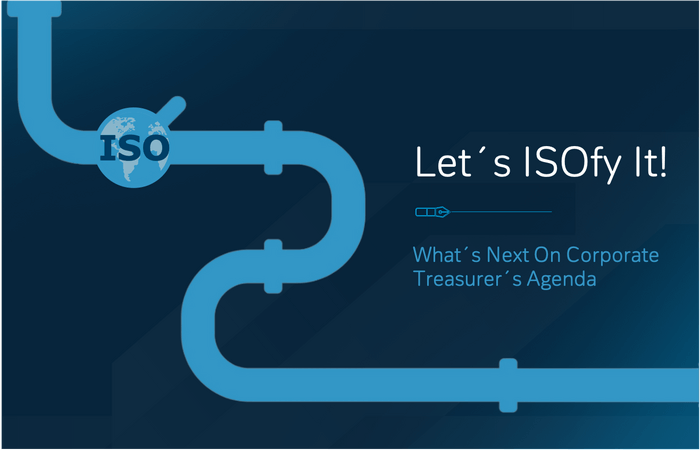May 18, 2021
Let´s ISOfy It! What´s Next On Corporate Treasurer´s Agenda
The ISO 20022 migration is a major overhaul of the global payments infrastructure and one of the hot topics in the payments industry – well, at least in the interbank space. While no bank conference passes without discussions on the progress, requirements and implications of this huge infrastructure project, there is less attention paid to what it means for payment users and in particular the Cash Management processes of Corporates. In the following I have tried to shed some light on this topic by answering a few key questions.

What is the ISO 20022 migration all about?
Cross-border and the majority of domestic treasury payment clearings are still using a quite ancient file format. Most transactions are based on some form of the FIN standard, which use the MT message types. This message format was introduced many years ago and does not cater for today’s needs in terms of data richness and structure.
Corporates are already quite familiar with the ISO format as it is used in many of the batch-based or instant clearings (e.g. SEPA or SEPA Instant). Even the Corporate-to-Bank message exchange of cross-border payments and reporting offers at least both alternatives: the MT101 and the pain.001 for payment initiation, and the MT940 and the camt.053 for end-of-day reporting. However, those ISO messages are not used to their full benefit today as the clearing or interbank processing in the middle limits the information that can be exchanged this way. Think of it like a water pipe: there is an inlet and an outlet that is capable of facilitating a larger throughput, but this is connected by small pipe in the middle which limits the flow. The ISO 20022 migration removes this bottleneck – replacing the small pipe in the middle with one that is much larger.
When is it all happening?
The scheduled migration timeline to ISO 20022 has been delayed in most markets due to Covid-19. When looking at some of the most important market infrastructures the new timelines are:
- SWIFT will start introducing ISO 20022 from November 2022, but will allow for legacy formats in the coexistence period until 2025. Mechanisms will be put in place to mitigate the risks resulting from data truncation
- Europe: In line with the SWIFT timelines, TARGET2 and EURO1 will migrate the processing to ISO 20022 by November 2022. This will happen as a single “big bang” approach and all participating banks need to comply
- UK: In June 2022 the new format will be introduced for CHAPS, although only by February 2023 will the full ISO information be used and allow for more information in the payment message
- US: Timelines are not confirmed at this stage, but the change is unlikely to happen before 2023
It should be noted that in addition to the above market infrastructures moving to ISO 20022, many other markets are following the same approach with similar timelines.
What does it mean for Corporates? Is it mandatory?
For Corporates there is some relief. The migration of SWIFT messages to ISO 20022 is only mandatory in the interbank area. Existing formats for the Corporate-to-Bank communication, such as the MT101 or MT940, will continue to be supported. Banks will manage the resulting complexity at their end – just as they do today for many other payment formats.
However, this all-clear is temporary in nature and comes with some caveats. By November 2025 at the latest, the use of structured address details will become mandatory. This means that for each element of the address (e.g. street, city) a dedicated field in the payment message needs to be used. While for the originator of the payment the bank could facilitate this structure as a service based on their own client address details, this does not work for the beneficiary address. Discussions on this are ongoing, but it could mean not only that Corporates need to provide information from their ERP or TMS system in a different way, it might also imply that the MT101 itself and other legacy formats are no longer appropriate and cannot be fully supported.
Furthermore, from November 2022 there is a risk that Corporates could receive incomplete information when using the MT940 or MT942 for reporting purposes. In case the originator of the payment makes use of the rich ISO data to provide information on the purpose of the payment, this would not be fully reflected in the MT940 account statement, leading to more challenging and manual reconciliation in the order-to-cash process. The same accounts for Ultimate Debtor/Ultimate Creditor information, which did not exist as dedicated fields in MT messages, but will be used in ISO.
Coming back to the analogy of the water pipe, the situation has now been reversed. Rather than the bottleneck sitting in the middle pipe – the clearing or market infrastructure layer – it now could sit with the inlet and outlet – or the payment initiation and reporting.
So any Corporate treasurer should recognize the necessity to gradually replace the existing FIN messages and migrate to the new messaging format for both payment initiation (pain.001) and reporting (camt. messages).
How can Corporates benefit from the migration?
The primary message of the ISO 20022 migration should focus less on “what does it do to a Corporate”, but “what can the ISO 20022 migration do for a Corporate?”, i.e. how Corporates can benefit from the new standard or leverage it to their benefit.
Indirectly, Corporates should experience first benefits from the increased efficiency in global payments. Today, delays in cross-border payments often relate to the necessity for manual compliance checks. Think, for example, of a beneficiary living in Cuba Avenue, Staten Island, New York. Today any payment for a beneficiary with this address would likely involve the payment being stopped and manually investigated. In future, “Cuba” will be provided in the dedicated street name field, enabling this payment to be processed without any disruption, instantly.
Moreover, in Europe, in addition to the introduction of ISO 20022, TARGET2 will extend its opening hours to start at 2:30 CET already. This will enable Euro payments to APAC to reach the beneficiary earlier in their business day – as those payments are usually routed via TARGET2 to the destination country, facilitating the local Corporate treasurer to further increase the efficiency of his liquidity management.
Next to those tangible, but more indirect benefits related to the infrastructure transformation itself, there are a few points where each Corporate, bank or technology provider can assess how to build a proposition and leverage the new opportunities. Corporates can further increase the transparency and efficiency of the processes in their In-house Bank by making use of Ultimate Debtor/Creditor fields to execute “on-behalf-of payments”. The reconciliation in the order-to-cash process can be optimised and further automated by making use of the comprehensive information available in camt. account statements. Treasury associations or individual supply chains may leverage this unique opportunity to discuss how best to evolve existing standards to make use of the new level of structured and rich information. And banks as well as tech providers can introduce new services, which they want to make available to their clients.
This is just the start of the journey and time will tell where the biggest benefits lie. All points have one aspect in common. They require the Corporate to gradually move to ISO over the next few years by considering the below steps:
- Adjust your ERP/TMS system and the process to capture structured data of counterparties – enabling straight-through-processing
- Consider early adoption of ISO 20022 account statements (camt.) to enable enhanced reporting & receive rich data contained in the payment messages
- Upgrade to the newest pain.001 version 9 (or consider using APIs) to enable seamless end-to-end flow of data (e.g. dedicated fields for services like payments tracking, account number proxies)
- Make use of Ultimate Debtor/Creditor fields to execute “on-behalf-of payments” out of central treasury set-ups
- Consider the use of Structured Remittance Information (available in a second step) to submit detailed, structured information to the beneficiary of a payment – enabling automated reconciliation and straight-through processing
- Make use of new reference structure, e.g. End-to-End Identification element from Debtor to Creditor, or UETR for payments tracking
- Support the introduction and use of the new ISO 20022 standard in your respective treasury associations and industry groups.

By Christof Hofmann,
Head of Corporate & Payment Solutions Back
